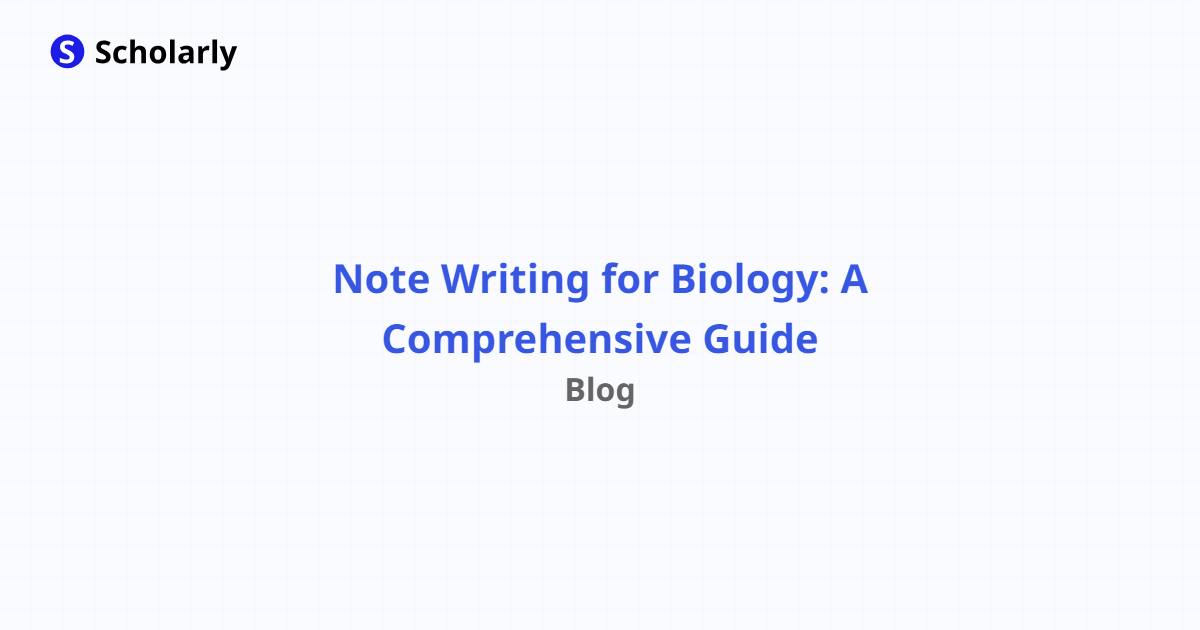Note Writing for Biology: A Comprehensive Guide
Learn the best practices for note writing in biology to effectively organize and retain information.

Introduction
Taking effective notes is crucial for successful learning and retention, especially in a complex subject like biology. In this comprehensive guide, we will explore the best practices for note writing in biology to help you organize and understand the vast amount of information.
History
In the past, biology note writing involved handwritten notes, highlighting important concepts, and creating diagrams to visualize complex processes. However, with the advent of digital tools and online resources, note writing has become more versatile and dynamic.
Current State
Today, biology students have access to a wide range of tools for note writing, such as note-taking apps, online platforms, and digital notebooks. These tools offer features like real-time collaboration, multimedia integration, and organization options that can enhance the note-writing process.
Future State
The future of note writing in biology is likely to be heavily influenced by artificial intelligence (AI). AI-powered tools can analyze and summarize complex biological concepts, recommend related resources, and even generate personalized study materials based on individual learning patterns.
Benefits
- Enhanced understanding and retention of biological concepts.
- Improved organization and structure of notes.
- Easy access and searchability of notes across devices.
- Collaborative note-taking for group study sessions.
- Integration of multimedia elements for better visualization.
Significance
Effective note writing in biology is significant because it allows students to synthesize complex information, identify key concepts, and reinforce learning. It also promotes active engagement with the subject matter, leading to higher comprehension and retention levels.
Best Practices
- Use a structured format such as Cornell notes or outlining.
- Focus on understanding concepts rather than copying information.
- Summarize information in your own words.
- Use visual aids like diagrams, flowcharts, and illustrations.
- Review and revise your notes regularly for better retention.
Pros and Cons
Pros
- Helps in organizing complex biological information.
- Promotes active learning and engagement.
- Facilitates revision and exam preparation.
- Can be easily digitized and shared.
- Allows for customization and personalization of notes.
Cons
- Initial time investment in learning note-taking techniques.
- Multitasking between listening and writing can be challenging.
- Limited space for detailed explanations in handwritten notes.
- Risk of relying too heavily on notes instead of active learning.
- Requires regular review for long-term retention.
Comparison
To enhance your biology note-taking experience, consider using these popular tools:
Evernote: A versatile note-taking app that allows you to organize your biology notes into notebooks, add images and audio recordings, and sync across devices. Link to Evernote
OneNote: Microsoft's digital notebook that offers features like handwritten notes, multimedia integration, and collaboration options. Link to OneNote
Notion: A powerful all-in-one workspace that lets you create databases, tables, and collaborative pages for biology note-taking. Link to Notion
AI Impact
In biology note writing, AI can play a significant role in various ways:
- Summarizing complex concepts and providing concise explanations.
- Recommending relevant study resources based on individual learning patterns.
- Generating flashcards or quizzes for active recall practice.
- Analyzing note-taking behavior and suggesting improvements.
Common Techniques
Active Listening and Concept Mapping: Actively engage in class lectures or online biology lessons by listening attentively and creating concept maps to connect different ideas.
Color-Coding and Highlighting: Use different colors or highlighters to differentiate between different types of information, such as definitions, examples, or important concepts.
Annotating Textbooks: Write margin notes, underline key points, and ask questions in the margins of your biology textbooks to facilitate comprehension and active reading.
Mind Mapping: Create visual diagrams that depict the interrelationships between different biological concepts, helping you see the bigger picture.
Reviewing and Summarizing: Regularly review your biology notes and summarize the main ideas in your own words, reinforcing your understanding and promoting retention.
Challenges
- Managing the vast amount of biological information and condensing it into concise notes.
- Ensuring accuracy and comprehensiveness while summarizing complex concepts.
- Balancing between active listening and note writing during class or lecture.
- Adapting to new note-taking tools and platforms.
- Overcoming the temptation to transcribe instead of summarizing and processing information.
Potential Online Apps that relate to the topic
Quizlet: A popular flashcard app for biology that allows you to create, study, and share digital flashcards with customizable content. Link to Quizlet
Khan Academy: An online learning platform that provides biology tutorials, practice exercises, and interactive quizzes. Link to Khan Academy
Biology Dictionary: An app that offers a comprehensive collection of biology-related terms, definitions, and explanations. Link to Biology Dictionary
Biology Videos: YouTube channels like CrashCourse Biology and Bozeman Science offer educational videos that explain biology concepts in an engaging and visual manner.
Conclusion
Effective note writing is a valuable skill for biology students to enhance learning, comprehension, and retention. By following the best practices, leveraging AI tools, and using appropriate techniques, you can create well-organized and meaningful biology notes that will support your academic success.
Try Our Popular AI Study Tools
Transform your study materials into interactive learning experiences with our most popular AI-powered tools:
PDF to Flashcards
Convert lecture notes and textbooks into study flashcards instantly
Text to Flashcards
Turn any text or notes into comprehensive flashcard sets
Image to Flashcards
Convert diagrams and handwritten notes into digital flashcards
YouTube to Flashcards
Generate flashcards from educational video content



